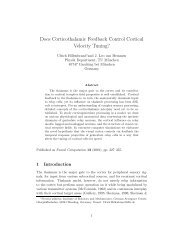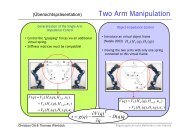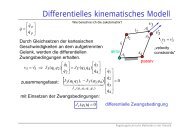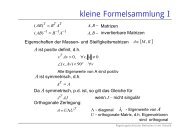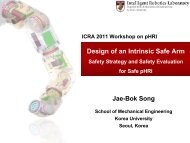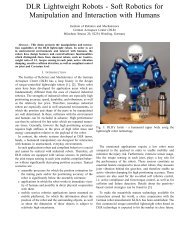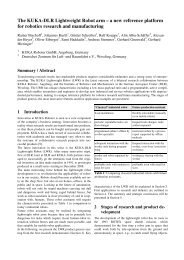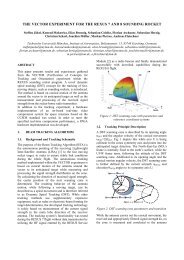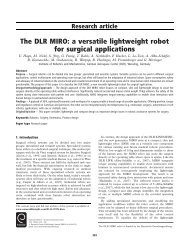View - IEEE Xplore
View - IEEE Xplore
View - IEEE Xplore
Create successful ePaper yourself
Turn your PDF publications into a flip-book with our unique Google optimized e-Paper software.
An Experimental<br />
Safety Study<br />
for Stab/Puncture<br />
and Incised<br />
Wounds<br />
By Sami Haddadin, Alin Albu-Sch€affer,<br />
Fahed Haddadin, J€urgen Roßmann,<br />
and Gerd Hirzinger<br />
•<br />
©CORBIS CORP.<br />
20 • <strong>IEEE</strong> ROBOTICS & AUTOMATION MAGAZINE • DECEMBER 2011 1070-9932/11/$26.00ª2011 <strong>IEEE</strong>
This article details<br />
the analysis of soft-tissue<br />
injuries caused by sharp<br />
tools that are mounted on/grasped<br />
by a robot [1]. The evaluation is considered<br />
as the next step down the road to a complete safety analysis of robots<br />
for human–robot interaction (HRI). We conduct an analysis of soft-tissue injuries<br />
based on available biomechanical and forensic data and present various experimental<br />
results with biological tissue for validation. Furthermore, possible countermeasures are proposed<br />
and evaluated by means of measurable injury reduction.<br />
Motivation and State of the Art<br />
Currently, increasing effort is taken in the robotics community to understand injury mechanisms<br />
during a physical HRI. This is motivated by the fact that human and robot will work intensively and<br />
closely together, and therefore, one has to be aware of the potential threats in case such a close cooperation<br />
takes place. There are two fundamental classes of contact-related injuries:<br />
1) blunt impact injury<br />
2) sharp contact injury.<br />
Until now, only blunt impacts were investigated in the robotics literature [see Figure 1(a)], leaving open<br />
the question of what can happen if a robot with an attached sharp tool on impacts with a human [cf. Figure<br />
1(b)]. If robots are allowed to work and help humans, they must be able to handle potentially<br />
dangerous tools and equipment. Tasks may range from slicing bread (see Figure 2) or preparing<br />
some meal to fulfilling the duties of a craftsman. This desired coexistence of humans and robots<br />
poses a serious safety problem that needs to be solved. Naturally, the reservation against robots<br />
handling sharp tools in human environments is enormously high. Industrial standards and<br />
obligations are generally very restrictive [2]. Until a robot will actually fulfill complex<br />
helper tasks in domestic environments using sharp tools, massive safety investigation<br />
is necessary. An important class of injuries to be analyzed in this context are softtissue<br />
injuries, of which the typical ones are described in the “Soft-Tissue<br />
Injury Caused by Sharp Tools” section. They range from usually less<br />
dangerous injuries as contusions or abrasions to very painful lacerations<br />
and even life-threatening ones such as stab/puncture<br />
wounds. Stab/puncture wounds are usually more<br />
lethal than laceration. However, for<br />
very sensitive zones, e.g.,<br />
Digital Object Identifier 10.1109/MRA.2011.942996<br />
Date of publication: 8 December 2011<br />
DECEMBER 2011 • <strong>IEEE</strong> ROBOTICS & AUTOMATION MAGAZINE • 21
Lightweight Design<br />
Singularity Avoidance<br />
Collision Detection<br />
and Reaction<br />
Safe Velocities<br />
Countermeasures<br />
Countermeasures<br />
Injury Measures<br />
Head Injury Criterion<br />
Neck Forces/Torques<br />
Compression Criterion<br />
Contact Forces<br />
Blunt Contact<br />
Injury Analysis<br />
Sharp Contact<br />
Injury Analysis<br />
(a)<br />
(b)<br />
Figure 1. (a) Current status of injury analysis in robotics. Mainly, the effect of blunt impacts was investigated. (b) The analysis of<br />
soft-tissue injury caused by sharp objects is still a largely open field. Neither injury analysis nor appropriate countermeasures have<br />
been investigated yet.<br />
around the area of the underlying arteria carotis, deep<br />
cuts can be equally dangerous.<br />
Although several countermeasures, criteria, and control<br />
schemes for safe physical HRI were proposed in the literature<br />
[3]–[9], the main objective of actually quantifying and<br />
evaluating them on a biomechanical basis was marginally<br />
addressed. First evaluations in this direction were carried<br />
out in [10], where the human pain tolerance was estimated<br />
on the basis of human experiments. In this work, the<br />
somatic pain was considered as a suitable criterion for<br />
Figure 2. Future service robots are supposed to work with possibly<br />
dangerous tools. How can we make robots safe for such tasks?<br />
determining a safety limit against mechanical stimuli. In<br />
[11] and [12], further attempts to overcome this drawback<br />
were mainly carried out in simulation, and recently in [13]–<br />
[15], an exhaustive evaluation of blunt impacts with various<br />
human body parts was carried out. Earlier work presented<br />
in [16] focused on a more abstract injury classification. The<br />
authors presented a first classification and hazard analysis,<br />
however, at this time, lacking in biomechanical motivation<br />
and experimental validation. In particular, they assumed an<br />
exhaustive protection of the human for the given concept.<br />
Reference [17] also discussed robot safety in human environments<br />
and pointed out the various potential threats.<br />
So far, the fundamental question of what is the resulting<br />
injury of a human during undesired contact was not discussed<br />
and analyzed in depth in the context of soft-tissue<br />
injury. Especially, the human biomechanics, injury tolerance,<br />
and injury severity were not considered or discussed<br />
on a quantitative basis. Previous works [6], [16] already<br />
introduced and analyzed skin stress as an injury index for<br />
assessing soft-tissue injury. Nevertheless, a real focus shift to<br />
the mentioned soft-tissue injuries was not carried out [18],<br />
[19]. In [18], the need for a complete evaluation of soft-tissue<br />
injury was given. In this work, the maximum curvature<br />
of a robot colliding with a human is approximated with a<br />
sphere. This is used to analyze the maximum tensile stress,<br />
which in turn is the basis to distinguish between safe and<br />
unsafe contact. In [19], a classification and synopsis of possible<br />
injuries in HRI was given. The influence of the different<br />
parameters and properties of the robot and the<br />
environment on the resulting injury severity was discussed,<br />
22 • <strong>IEEE</strong> ROBOTICS & AUTOMATION MAGAZINE • DECEMBER 2011
and various injury indices, e.g., contact force or energy<br />
density, were proposed.<br />
Generally, soft tissue injury analysis in robotics was<br />
mainly model based so far. Knowing from our experience<br />
how uncertain and contestable simple models (and their<br />
parameterization) for such complex biomechanical processes<br />
are, we decided to treat this topic empirically and<br />
acquire real data for injury thresholds. We think that these<br />
experiments provide reliable facts and can constitute a help<br />
for further evaluation and validation of models.<br />
Several aspects are treated in this article, leading to<br />
three main contributions:<br />
1) to evaluate soft-tissue injuries caused by various possibly<br />
dangerous tools, we deal with stab/puncture and<br />
incised wounds<br />
2) to prove the effectiveness of our collision detection and<br />
reaction schemes for the Lightweight Robot III (LWR-<br />
III) of the German Aerospace Center (DLR) with softtissue<br />
and volunteer tests; these countermeasures give<br />
us the possibility to drastically reduce the injury potential<br />
during stabbing and prevent even the slightest cutaneous<br />
injury during cutting<br />
3) to provide empirically relevant limit values for injury<br />
prevention for the case of sharp contact.<br />
Soft-Tissue Injury Caused by Sharp Tools<br />
Biomechanics of Soft-tissue Injury<br />
Sharp contact can cause various characteristic injuries in the<br />
context of robotics. The most important ones are abrasions,<br />
contusions, lacerations, incised wounds, and puncture wounds.<br />
l Abrasions or excoriations are the ablation of parts or the<br />
entire epidermis from the corium.<br />
l Contusions are basically bleedings into tissue that can<br />
be found in the skin, muscles, and inner organs.<br />
l A laceration can be described as a tear in the tissue, i.e.,<br />
the tissues are torn apart and remain irregular.<br />
l An incised wound is a transection in skin continuity which<br />
is wider than it is deep. This is especially the result of a cut.<br />
l A puncture or stab/puncture wound on the other hand is<br />
usually characterized by being deeper than it is wide.<br />
y<br />
x<br />
Soft Tissue<br />
(a)<br />
Elastic Deformation<br />
x p = x(F p , t p )<br />
y<br />
x<br />
Soft Tissue<br />
Penetration<br />
Figure 3. (a) Elastic deformation of the skin before penetration<br />
up to x p at a force level of F p . (b) Penetration depth d p into the<br />
tissue after exceeding the tolerance force F p .<br />
(b)<br />
d p<br />
In this article, we focus on stab/puncture wounds and<br />
incised wounds/cuts in order to capture the vast threat posed<br />
by sharp tools such as knifes, scalpels, or scissors and leave the<br />
low-severity injuries for future research. (We are currently preparing<br />
systematic drop-testing experiments to analyze the biomechanics<br />
of such injury.)<br />
The influence of underlying bones is neglected, and the<br />
evaluation focuses on areas such as the abdomen or thigh.<br />
This can be considered as a worst-case scenario since the<br />
underlying soft tissue is very sensitive and a bone would<br />
reduce the possible injury severity by means of penetration<br />
depth (apart from the case of slipping or impinging). If, e.g.,<br />
an object hits the human thorax above the heart location and<br />
penetrates further, it is possible to hit a heart-protecting rib.<br />
In case the object neither slips nor impinges nor exerts forces<br />
that are able to cause rib fracture, the possible injury is<br />
limited from the tissue to the rib and further rib injury (e.g.,<br />
penetration into the rib). This is of course significantly less<br />
dangerous if the robot tip penetrated between the two ribs<br />
and reached the cardiac tissue. The analysis of these relaxed<br />
situations is left for future work.<br />
Stab/puncture wounds were investigated in the forensic<br />
literature with different knives, and it was concluded that<br />
strain is not an appropriate measure to define the tolerance<br />
value for knives and similar tools because the contact area<br />
is too small [20]–[22]. Instead, the evaluation of the penetration<br />
force F p is proposed, which in our opinion, is well<br />
suited to be used in the context of robotics as well. Tolerance<br />
forces depend on the layers of clothing and range<br />
according to [21] between<br />
l ¼ 76 45 N for uncovered skin<br />
FP 1<br />
l Fp 2<br />
¼ 173 N for three layers of a typical clothing.<br />
Furthermore, the tolerance force correlates to a skin<br />
deflection x p at which the actual penetration takes place.<br />
This deflection is<br />
l<br />
l<br />
xp 1 ¼ 1:24 0:49 cm for naked skin<br />
x 2 p ¼ 2:26 0:61 cm for multilayered clothes. (This<br />
evaluation was carried out at low velocities by determining<br />
the static stab force. However, in [22], dynamic tests<br />
were conducted and produced similar numerical values.<br />
In [23], stab tests with three different knives led to significantly<br />
lower penetration values.)<br />
In this article, we assume the relationship to be linear in<br />
first approximation. Therefore, the skin can be modeled by<br />
a stiffness before penetration and a tolerance force that<br />
corresponds to the moment of penetration (Figure 3).<br />
Therefore, we assume the following contact model<br />
(<br />
Fp<br />
i F<br />
K H, i ¼<br />
xp<br />
i ext < Fp i ,<br />
0 F ext Fp i ,<br />
where F ext is the contact force acting on the human and<br />
robot, respectively. What happens after the knife actually<br />
penetrates is to our knowledge still not investigated yet and<br />
needs further treatment and evaluation. The first hints<br />
(1)<br />
DECEMBER 2011 • <strong>IEEE</strong> ROBOTICS & AUTOMATION MAGAZINE • 23
given in [22] show that a second resistance after the initial<br />
skin penetration can be observed. As a first indicator, we<br />
considered the intrusion/penetration depth d p to be a relevant<br />
quantity (of course depending on the location where<br />
the skin is actually penetrated and its underlying tissue) in<br />
our experiments to evaluate the severity of injury.<br />
According to [24], no similar investigation of incised<br />
wounds/cuts was carried out. This is presumably due to the<br />
nonexisting forensic necessity. In this sense, our analysis will<br />
bring new insights to the understanding of this injury<br />
mechanism in a broader sense and is not limited to robotics.<br />
Next, we present the results on depth measurements of<br />
vital organs, since we believe this is a relevant injury indicator<br />
that is applicable to robotics in the sense that it provides inherent<br />
minimum requirements on the robot-braking distance.<br />
The Depth of Vital Organs<br />
To quantify potentially lethal stabs, we conducted ultrasonic<br />
measurements with ten human subjects to estimate<br />
the distance from the skin surface to the surface of the<br />
human heart. Between the fourth and fifth intercostellar<br />
spaces, the depth is measurable since the heart abuts on the<br />
thorax wall. Numerical values of d heart ¼ 2:2–2:7 cm were<br />
measured with a mean of d heart ¼ 2:4cm.<br />
In addition to the initial heart depth analysis, we<br />
conducted measurements for several vital organs. (The<br />
measurements had no diagnostic nor therapeutical purposes<br />
and did not cause any injury. The subjects were anonymous.<br />
The ultrasonic system used a ESAOTE Megas, yoc 2005.<br />
We use a 7:5-MHz probe for the throat and neck soft tissues<br />
and a 3:5-MHz probe for the other organs.) The mean<br />
results of the depth measurements are as follows:<br />
l Or1: heart, 2:2cm<br />
l Or2: abdominal aorta, 6:0cm<br />
l Or3: liver (side), 2:0cm<br />
l Or4: liver (subcostal), 3:7cm<br />
l Or5: kidney (back), 5:0cm<br />
l Or6: soft tissue throat (right), 1:3cm<br />
l Or7: soft tissue throat (left), 1:3cm<br />
l Or8: subclavia, 1:6cm<br />
l Or9: milt, 3:8cm.<br />
The short distances clearly point out how vulnerable<br />
human organs are as soon as penetration occurs.<br />
Since it is very difficult to estimate the particular injury<br />
a human would suffer from sharp contact, we believe it is<br />
important to define the requirements for robot design and<br />
control, which quantify the benefit one would, e.g., obtain<br />
from a collision detection and reaction strategy in an intuitive<br />
manner. An important value that is a natural candidate<br />
is the maximum braking distance of a robot.<br />
Braking Distance<br />
As shown in the previous subsection, the organ depth<br />
d organ is an intuitive number that can be used as a minimum<br />
braking distance, which absolutely needs to be<br />
ensured during sharp robot–human contact.<br />
External contact forces caused by the human dynamic<br />
response potentially decrease the braking distance, especially,<br />
for low inertia robots. Therefore, the worst-case<br />
braking distance is present without taking this into consideration.<br />
It consists of three phases:<br />
1) nominal motion before collision detection triggers (system<br />
delay, detection sensitivity): t 0 ! t 1<br />
2) nominal motion before stopping reaction strategy activates<br />
(system latencies): t 1 ! t 2<br />
3) stopping motion till entire stop of the system (actuator<br />
dynamics/saturation): t 2 ! t 3 .<br />
Therefore, the overall braking distance that needs to be<br />
smaller than d organ is<br />
Z t2<br />
Z t3<br />
jjx stop jj ¼ _x nom dt þ _x brake dt < d organ : (2)<br />
t 0<br />
t 2<br />
This limit is from our perspective a good choice to qualify<br />
the effectivity of collision detection and reaction schemes,<br />
since it is an absolute limit before a life-threatening injury<br />
occurs if penetration into the body takes place. It inherently<br />
defines the minimum performance characteristics on<br />
joint torque dynamics by means of maximum joint torque<br />
and response time.<br />
After the introduction of necessary biomechanical/forensic<br />
definitions and our performance/injury measure, the<br />
used collision detection and reaction methods are briefly<br />
overviewed. Furthermore, their use as a countermeasure to<br />
soft-tissue injury caused by sharp tools is motivated by a<br />
simulation since it initially seemed not very realistic to be<br />
able to prevent, e.g., injuries caused by knives and scalpels.<br />
While the detection and reaction strategies are the outcome<br />
of a joint work in cooperation with the University of<br />
Rome [4], [25], the present article uses this as a tool for a<br />
biomechanical evaluation of possible soft-tissue injuries<br />
with and without collision detection.<br />
Collision Detection and Reaction<br />
Countermeasures against soft-tissue injury can be manifold,<br />
but a crucial feature has to be the effective physical<br />
collision detection and reaction. An important aspect is<br />
to decide whether a detected interaction force for the<br />
robot is currently fulfilling a desired task (e.g., preparing<br />
food) or constitutes a potential threat. However, from our<br />
point of view, this is a question of higher-level planning<br />
and human motion detection involving external sensing,<br />
e.g., a vision system. This separate topic is clearly out of<br />
the scope of this article. A rather simple scheme for distinguishing<br />
whether the occurring collision is part of the<br />
assembly task or a collision with the human could be to<br />
switch the collision detection off as soon as clamping of<br />
the human can be excluded. This can be ensured if the<br />
distance between the tool and the known environment<br />
(table) is lower than a threshold. In this situation, a very<br />
good world model is of course necessary, which could be<br />
thecaseinanindustrialscenario.<br />
24 • <strong>IEEE</strong> ROBOTICS & AUTOMATION MAGAZINE • DECEMBER 2011
Generally, as soon as a collision is identified, various<br />
reaction schemes could be activated. In case of mounted<br />
sharp tools, this reaction scheme needs to be treated very<br />
carefully, since activating, e.g., the strategy of a free-floating<br />
compliant robot, is still a dangerous threat with a<br />
mounted (or grasped) knife (of course, a reduced one compared<br />
with a robot moving in position control).<br />
The DLR Lightweight Robot III<br />
In our evaluation, we conducted simulations and experiments<br />
with the LWR-III. The LWR-III is a 7 degrees-offreedom<br />
lightweight robot with 1.1 m reach, moderately<br />
flexible joints (due to the use of harmonic drives and joint<br />
torque sensors), and was explicitly developed for the direct<br />
physical interaction and cooperation with humans. Its total<br />
weight is 15 kg and the nominal payload is 7 kg. (Please<br />
note that the robot is able to carry its own weight of 7 kg<br />
for research applications.) Furthermore, it is equipped with<br />
joint torque sensors in each joint, enabling the sensing of<br />
external contact forces along the entire robotic structure.<br />
For details concerning the full design of the robot, please<br />
refer to [26] and [27].<br />
Compared with the soft-tissue properties of the used<br />
subjects during the investigated collisions throughout this<br />
article, the robot is very stiff. Thus, thresholds of penetration<br />
forces and other properties obtained by our measurements<br />
are not valid only for this particular robot but can<br />
directly be applied to other robots.<br />
Collision Detection<br />
The collision detection used in this work was introduced<br />
and analyzed in [4], [28], and [25]. Its basic concept is to<br />
observe the generalized momentum p ¼ M(q) _q, asproposed<br />
in [7] and [29], with M 2 R n 3 n being the manipulator<br />
mass matrix and q, _q 2 R n the link position and<br />
velocity. It can be proven that the observed disturbance br is<br />
a componentwise filtered version of the real external torque<br />
s ext 2 R n ,i.e.,br s ext . This enables us to detect contact<br />
along the entire structure of the robot without additional<br />
external sensing. The collision threshold d c 2 R n (ideally,<br />
d c ¼ 0) is mainly due to sensor noise and model uncertainties.<br />
For the real LWR-III, this corresponds to d c ¼ 0:03s max ,<br />
i.e., 3% of the maximum nominal torque, s max 2 R n ,ofthe<br />
robot. (For the LWR-III, the maximum nominal joint torques<br />
are s max ¼½180 180 80 80 80 35 35Š T NÆm). This value<br />
indicates that very low contact forces can be detected.<br />
Collision Reaction<br />
After a collision is detected and isolated, we instantaneously<br />
trigger an appropriate collision reaction scheme.<br />
<br />
s d ¼ s d, nom 8i : j^r i j < d c, i ,<br />
s d, col 9j^r i jd c, i ,<br />
where s d, nom: is the nominal torque input for motion control<br />
and s d, col depicts the control input for an appropriate<br />
(3)<br />
reaction scheme. Various strategies were proposed in [4]<br />
and [28], and three of them are tested and compared in this<br />
article for soft-tissue contact (silicone, pig) with sharp<br />
tools. One goal is to be able to evaluate the effectivity of the<br />
detection in a critical scenario. As discussed in the “Safety<br />
Experiments” section, the collision detection can make the<br />
difference between serious, even, lethal injuries and no<br />
injury at all. The investigated collision strategies are<br />
l Strategy 0: Keep the reference movement, i.e., show no<br />
reaction at all and continue to follow h d , where h d 2 R n<br />
is the desired motor position. This is the reference<br />
behavior.<br />
l Strategy 1: Stop the robot as soon as a collision is<br />
detected, meaning to set h d ¼ h(t c ), where h 2 R n is the<br />
motor position and t c is the instance of collision<br />
l<br />
detection.<br />
Strategy 2: Switch from position control to zero-gravity<br />
torque control [30], [31] and let the robot react in a<br />
convenient and compliant manner.<br />
Before presenting the experiments, a simulation use<br />
case is discussed, which was our initial motivation for evaluating<br />
collision detection and reaction for a robot that<br />
moves such dangerous tools.<br />
A Simulation Use Case with the LWR-III<br />
Here, the penetration of the human skin with a knife and<br />
its prevention is treated. A simple and reasonable contact<br />
model for stabbing is available as mentioned in the “Soft-<br />
Tissue Injury Caused by Sharp Tools” section. We use the<br />
model for the fully covered human, i.e., Fp 2 ¼ 173 N and<br />
xp 2 ¼ 2:26 0:61cm: For simulating the stabbing process,<br />
the following elastic joint model is assumed. (For the<br />
LWR-III, the nonnegligible joint elasticity between motor<br />
and link inertia due to the harmonic drive gears and the<br />
joint torque sensor has to be taken into account into the<br />
model equation, leading to the standard flexible joint<br />
model proposed in [32]):<br />
M(q)€q þ C(q, _q) _q þ g(q) ¼ s J þ s ext , (4)<br />
B € h þ s J þ s F ¼ s m , (5)<br />
s J ¼ K J (h q), (6)<br />
with h 2 R n being the motor side position, s J 2 R n , s F the<br />
elastic joint and friction torque, K J ¼ diagfK J, i g2R n 3 n<br />
the diagonal positive definite joint stiffness matrix, and<br />
B ¼ diagfB i g2R n 3 n the diagonal positive definite motor<br />
inertia matrix. The controller is the full-state feedback controller<br />
from [30]. s ext is associated with the (generalized)<br />
Cartesian collision force F ext by<br />
s ext ¼ J T c (q)F ext, (7)<br />
where J c (q) is the (geometric) contact Jacobian. The force<br />
F ext is generated by (1). (Please note that we assume no<br />
change in behavior due to penetration in the simulation. In<br />
DECEMBER 2011 • <strong>IEEE</strong> ROBOTICS & AUTOMATION MAGAZINE • 25
other words, a constant stiffness model is used.) The<br />
human soft tissue is modeled as a virtual wall with the<br />
already mentioned spring constant and is assumed to be<br />
clamped, i.e., a worst-case scenario is treated. The robot is<br />
mounted on a fixed base. The maximum joint velocity of<br />
the robot is 120 /s, and the desired motion is a straight line<br />
with reconfiguration from elbow up to elbow down. The<br />
maximum Cartesian velocity results from the maximum<br />
joint velocity in the fourth joint, whereas the second and<br />
the seventh joint drive at half the velocity, resulting in a<br />
maximum Cartesian velocity of 0:64 m/s. In this simulation,<br />
the Cartesian impact velocity was chosen to be<br />
_x R<br />
2f0:16 0:32 0:64g m/s for the fully covered skin. In<br />
Figure 4, the results of the contact forces are shown.<br />
Clearly, the effectiveness of the collision detection and<br />
reaction is apparent even for high Cartesian velocities.<br />
Severe injury can be caused after penetration of the skin<br />
without any collision reaction. On the other hand, the skin<br />
is not penetrated for active strategies since the robot is able<br />
to react sensitive and fast enough to prevent the human<br />
from being hurt. Furthermore, the properties of the collision<br />
reaction strategies become apparent: Strategy 1<br />
actively stops the robot and reduces the contact force significantly<br />
faster than does Strategy 2. On the other hand,<br />
the switch in control (Strategy 2) reduces the contact force<br />
down to zero in contrast to Strategy 1. This is due to the<br />
passive behavior of the robot in a torque-controlled mode<br />
with gravitation compensation. Even for 0:64 m/s, the<br />
Force (N)<br />
Force (N)<br />
Force (N)<br />
300<br />
200<br />
100<br />
0<br />
0 0.05 0.1 0.15 0.2 0.25 0.3 0.35 0.4 0.45 0.5<br />
Time t (s)<br />
(a)<br />
400<br />
300<br />
200<br />
x R = 0.32 m/s<br />
2<br />
F p<br />
100<br />
0<br />
0 0.05 0.1 0.15 0.2 0.25 0.3<br />
Time t (s)<br />
(b)<br />
400<br />
300<br />
200<br />
100<br />
x R = 0.16 m/s<br />
x R = 0.64 m/s<br />
0<br />
0 0.02 0.04 0.06 0.08 0.1 0.12 0.14 0.16 0.18 0.2<br />
Time t (s)<br />
(c)<br />
Strategy 0 Strategy 1 Strategy 2 Collision Detection<br />
collision detection is able to prevent damage of the skin.<br />
Figure 4 (a) shows the results for a joint velocity of 30 /s, 4<br />
(b) 60 /s, and 4 (c) 120 /s in the fourth (elbow) joint. 120 /<br />
s is the current maximum joint velocity of the LWR-III.<br />
This simulation shows how easy it is to penetrate the<br />
human skin even with a robot moving at moderate speeds<br />
and the human being protected by three layers of clothing.<br />
Penetrating the human skin itself seems to be a marginal<br />
injury, but at the same time, there are various vital organs<br />
such as the heart or the liver located relatively close to the<br />
body surface (see “The Depth of Vital Organs” section).<br />
Based on these observations, a combination of both<br />
strategies seems to be the best choice. This could be realized<br />
using Strategy 1 for stopping the penetration quickly<br />
(and minimizing the force profile) and then switch to torque<br />
control with gravity compensation (Strategy 2) for<br />
being compliant after having stopped. This would prevent<br />
clamping of the human after the collision as one can easily<br />
push the robot away. An implementation example of a<br />
more complex behavior is shown in Figure 5. The depicted<br />
example is a possible implementation for the free space<br />
motion with a three-stage reaction strategy. Initially, the<br />
robot state is in its wait state W. After receiving the Go<br />
command a desired free motion task is performed in state<br />
R. If a slight collision (HF ¼ 1) is detected in R the robot<br />
reacts to it by switching to Strategy 1 that is performed by<br />
state S 1 .InS 1 the kinetic energy E kin of the robot is monitored<br />
and when this drops below the predefined threshold<br />
the robot switches to state S 2 , i.e.,<br />
to reflex Strategy 2. Now the robot<br />
behaves compliant and can be easily<br />
pushed away or moved to a desired<br />
F p<br />
2<br />
F p<br />
2<br />
location by the human. If the human<br />
operator confirms (CF ¼ 1) the<br />
robot leaves the reaction strategy<br />
and switches back to the wait state<br />
W. Apart from this nominal collision<br />
behavior, the robot is also able<br />
to react with an emergency strategy<br />
if a very severe collision was<br />
observed (FT1 ¼ 1). When switching<br />
to S 3 the robot engages its brakes<br />
and waits for human initiative. The<br />
operator may now actively confirm<br />
the robot to switch to its nominal<br />
wait state W again.<br />
After this discussion on collision<br />
detection and reaction, various<br />
experiments that are presented next<br />
provide insight about the injury<br />
mechanisms during contact with<br />
various sharp tools.<br />
Figure 4. Stabbing simulation with the full dynamic model of the LWR-III equipped with<br />
a knife. The fully covered human stands 0:3 m before the stretched out singularity of the<br />
robot. Fp 2 denotes the penetration force for the fully covered skin.<br />
Safety Experiments<br />
In this section, various experiments<br />
are presented and the injury severity<br />
26 • <strong>IEEE</strong> ROBOTICS & AUTOMATION MAGAZINE • DECEMBER 2011
possibly occurring if a robot with a sharp tool penetrates a<br />
soft material is analyzed. The dynamics of such an impact<br />
is especially worth being investigated since, during rigid<br />
(unconstrained) collisions [13], the dynamics is so fast that<br />
a realistic robot is not able to reduce the impact characteristics<br />
by the collision detection and reaction. However,<br />
during our previous investigations, a subjective safe feeling<br />
could be definitely experienced by the users. Despite this<br />
limitation in reactivity to blunt impacts, it was shown that<br />
the necessity of countermeasures is not absolutely crucial<br />
since rigid free impacts pose only a very limited risk at the<br />
typical robot velocities up to 2 m/s. This is definitely not<br />
the case for soft-tissue injuries caused by a stab because the<br />
injury severity due to penetration can reach lethal dimensions.<br />
The particular worst case depends on the exact location<br />
by means of potentially injured underlying organs.<br />
Because of the much slower dynamics compared with rigid<br />
impacts, the requirements on a reactive robot concerning<br />
detection and reaction speed are somewhat relaxed and not<br />
unachievableforsuchsituationsasexemplifiedinthe“A<br />
Simulation Use Case with the LWR-III” section. It seems<br />
surprising at first glance that it is not possible to counterbalance<br />
rigid blunt robot–human impacts by means of controls<br />
that are definitely not life threatening, but at the same time,<br />
dangerous or even lethal contacts with tools seem manageable<br />
to a certain extent. (Please note that we refer to impact<br />
speeds of up to 2 m/s.) One purpose of the present experiment<br />
is to prove this statement.<br />
In the framework of this article, the situation in which<br />
the robot moves in position control with/without collision<br />
detection by utilizing joint torque sensing is considered.<br />
The contact force is measured with a JR3 force–torque sensor<br />
in the wrist. Please note that this sensor is only used for<br />
measurement and not for collision detection.<br />
Investigated Tools<br />
The variety of tools one could analyze are basically countless<br />
and, therefore, a representative selection of tools with<br />
different sharpness was carried out (Figure 6). Up to now,<br />
there is no benchmarking test of tools, since the underlying<br />
biomechanics is not fully understood yet. Therefore, we<br />
chose typical household objects such as knives of different<br />
sharpness, a scalpel, and a screwdriver. These tools were<br />
selected as a reasonable choice of potentially dangerous<br />
ones one could think of in robotic applications. They were<br />
removed from their original fixtures and glued into new<br />
mountings. Therefore, a fixed connection between the tool<br />
and a robot can be guaranteed, and no compliance reduces<br />
the transferred forces. This selection enables us to test a<br />
wide range of cuts and stabs with varying blade characteristics<br />
and sharpness. Currently, we are preparing a systematic<br />
biomechanical test to provide a set of benchmarking<br />
objects for investigating soft-tissue injury. The tools were<br />
tested in the same condition they were bought, except for<br />
the fact that they were glued into a rigid mounting to<br />
remove eventually beneficial compliances.<br />
R<br />
Go<br />
HF1 = 1<br />
CF = 1<br />
CF = 1<br />
E<br />
S kin ≤<br />
1 S 2 S 3<br />
∋<br />
Silicone Block<br />
As a first experimental contact material, a silicone block<br />
was used to get a feeling for the sensitivity and effectiveness<br />
of the collision detection and reaction for soft contact.<br />
(The used silicone was Silastic T2 with a Shore<br />
hardness of A40.) These first tests were conducted at a<br />
Cartesian velocity of 0:25 m/s, which is the recommended<br />
velocity according to International Standards<br />
Organization (ISO) 10218 for collaborative robots [2].<br />
The mounted tool is the kitchen knife. The desired goal<br />
configuration was located at a depth of 8 cm in the silicone<br />
block. Without any reaction strategy, the achieved<br />
penetration was 35 mm at a contact force of 220 N with<br />
W<br />
FT1 = 1<br />
Symbol Meaning<br />
States W Wait State<br />
R Running State<br />
S 1 Collision Strategy 1 State<br />
S2 Collision Strategy 2 State<br />
S 3 Collision Strategy 3 State<br />
Events Go Go Event for Starting Process<br />
Signals HF1 Collision of Severity-Level HF1<br />
FT1 Collision of Severity-Level FT1<br />
E kin Kinetic Energy of the Manipulator<br />
Kinetic Energy Threshold<br />
∋<br />
Figure 5. Combining the different collision reaction techniques<br />
to complex reflex behaviors.<br />
Blade<br />
Fixture<br />
Mounting<br />
(a) (b) (c) (d) (e)<br />
Figure 6. Investigated tools: (a) Scalpel, (b) kitchen knife, (c)<br />
scissors, (d) steak knife, and (e) screwdriver.<br />
DECEMBER 2011 • <strong>IEEE</strong> ROBOTICS & AUTOMATION MAGAZINE • 27
x<br />
y<br />
z<br />
Pig<br />
F/T-Sensor<br />
Tool<br />
Pig Experiments<br />
To obtain results with real biological tissue, we conducted<br />
experiments with a pig leg (Figure 7). From an anatomical<br />
point of view, pigs are commonly accepted as being similar<br />
to human beings. The stabbing trajectory is a straight line<br />
along the z axis and the desired configuration is slightly<br />
above the table. The pig is located on a rigid table, i.e., a<br />
clamping scenario is analyzed because of its worst-case<br />
properties. Both impact experiments in automobile crash<br />
testing and forensic medicine use these for first experiments<br />
or even for predictions of results with human tissue. Differences<br />
to humans and changing tissue properties through<br />
mortex and room temperature are apparent but yet it seems<br />
to be of immanent importance to conduct experiments with<br />
natural tissue. To our understanding, these investigations<br />
can be fundamental to robotic safety since classical impact<br />
experiments with knives in forensic medicine [21], [22] did<br />
(of course) not take any robot behavior into account, which,<br />
in turn, vastly influences the resulting injury.<br />
Figure 7. Testing setup for the pig experimental series. The<br />
robot is equipped with a JR3 force/torque sensor for measuring<br />
the contact force. The tools are rigidly mounted to the robot<br />
such that no significant additional compliance is introduced.<br />
joint six exceeding its maximum joint torque. This<br />
causes a low-level safety feature for robot protection to<br />
immediately stop the manipulator by engaging its<br />
brakes. With activated collision detection and reaction,<br />
the maximum penetration depth was significantly<br />
reduced to 6 mm at a contact force of 40 N, i.e., a<br />
reduction by a factor of 5.<br />
Stabbing<br />
Table 1 and Figure 8 summarize the outcome of the stabbing<br />
tests. The trajectory of the robot was chosen such<br />
that it moves on a straight vertical line along the z axis<br />
(cf. Figure 7) contacting the skin in normal direction with<br />
the tool axis. The investigated robot velocities were 0:16<br />
and 0:64 m/s. Each experiment with Strategy 1 or 2 was<br />
carried out two to three times. The results were very similar<br />
during independent trials with an error of maximum<br />
5% in the force profile. Surprisingly, with the screwdriver<br />
mounted, the robot was not able to penetrate the pig skin<br />
at all. For this tool, the maximum nominal joint torques<br />
Table 1. The results of the stabbing experiments.<br />
•<br />
_x R<br />
¼ 0:16 m/s _x R<br />
¼ 0:64 m/s<br />
Exp. No. Tool Strategy d p (mm) t p (ms) F p (N) x p (mm) Exp. No. d p (mm) t p (ms) F p (N) x p (mm)<br />
A1.1 Steak knife 0 full 100 15 14 A1.2 Full 14 11 10<br />
A2.1 1 None/4 — — — A2.2 22 14 11 10<br />
A3.1 2 3–5 100 15 14 A3.2 64 14 11 10<br />
B1.1 Scissors 0 Full 195 60 25 B1.2 Full 47 65 29<br />
B2.1 1 None — — — B2.2 18 34 45 21<br />
B3.1 2 None — — — B3.2 42 42 65 25<br />
C1.1 Kitchen knife 0 98 240 76 29 C1.2 135 55 73 32<br />
C2.1 1 None — — — C2.2 1 48 60 29<br />
C3.1 2 None — — — C3.2 18 55 76 31<br />
D1.1 Scalpel 0 Full 50 5 8 D1.2 Full 15 5 10<br />
D2.1 1 17 50 5 8 D2.2 17 15 5 10<br />
D3.1 2 17 50 5 8 D3.2 39 15 5 10<br />
28 • <strong>IEEE</strong> ROBOTICS & AUTOMATION MAGAZINE • DECEMBER 2011
Force (N)<br />
Force (N)<br />
Force (N)<br />
Force (N)<br />
Force (N)<br />
300<br />
250<br />
200<br />
150<br />
100<br />
50<br />
0<br />
0 0.1 0.2 0.3 0.4 0.5 0.6 0.7 0.8 0.9 1<br />
Time t (s)<br />
100<br />
80<br />
60<br />
40<br />
20<br />
0<br />
0 0.1 0.2 0.3 0.4 0.5 0.6 0.7 0.8 0.9<br />
Time t (s)<br />
100<br />
80<br />
60<br />
40<br />
20<br />
0<br />
0 0.1 0.2 0.3 0.4 0.5 0.6 0.7 0.8 0.9<br />
Time t (s)<br />
200<br />
150<br />
100<br />
50<br />
0<br />
Mounting<br />
−50<br />
0 0.1 0.2 0.3 0.4 0.5 0.6 0.7 0.8<br />
Time t (s)<br />
80<br />
60<br />
40<br />
20<br />
0<br />
x R = 0.16 m/s<br />
x R = 0.16 m/s<br />
x R = 0.16 m/s<br />
Mounting<br />
x R = 0.16 m/s<br />
x R = 0.16 m/s<br />
Fixture<br />
Maximum<br />
Joint-Torques<br />
Exceeded<br />
−20<br />
0 0.05 0.1 0.15 0.2 0.25 0.3 0.35 0.4<br />
Time t (s)<br />
(a)<br />
(b)<br />
(c)<br />
(d)<br />
(e)<br />
Force (N)<br />
Force (N)<br />
Force (N)<br />
Force (N)<br />
Force (N)<br />
350<br />
300<br />
250<br />
200<br />
150<br />
100<br />
50<br />
0<br />
200<br />
150<br />
100<br />
50<br />
0 0.05 0.1 0.15 0.2 0.25 0.3<br />
Time t (s)<br />
Mounting<br />
0<br />
0 0.02 0.04 0.06 0.08 0.1 0.12 0.14 0.16 0.18 0.2<br />
Time t (s)<br />
200<br />
150<br />
100<br />
50<br />
Mounting<br />
0<br />
0 0.02 0.04 0.06 0.08 0.1 0.12 0.14 0.16 0.18 0.2<br />
Time t (s)<br />
80<br />
60<br />
40<br />
20<br />
0<br />
−20<br />
0 0.05 0.1 0.15 0.2<br />
Time t (s)<br />
200<br />
150<br />
100<br />
Strategy 0 Strategy 1 Strategy 2 Collision Detection<br />
50<br />
x R = 0.64 m/s<br />
x R = 0.64 m/s<br />
x R = 0.64 m/s<br />
x R = 0.64 m/s<br />
x R = 0.64 m/s<br />
Maximum<br />
Joint-Torques<br />
Exceeded<br />
Mounting<br />
0<br />
Fixture<br />
−50<br />
0 0.05 0.1 0.15 0.2 0.25 0.3<br />
Time t (s)<br />
Figure 8. Results of stabbing tests with and without collision detection for the pig tests. (a) screwdriver, (b) steak knife, (c) scissors,<br />
(d) kitchen knife, and (e) scalpel. The arrows denote the moment of penetration.<br />
DECEMBER 2011 • <strong>IEEE</strong> ROBOTICS & AUTOMATION MAGAZINE • 29
always exceeded, and a low-level safety mechanism<br />
engaged the brakes of the robot, as described in the<br />
“Silicone Block” section. For the other tools, Table 1 gives<br />
the measured values for the penetration depth d p , the penetration<br />
time t p (which can be interpreted as the available<br />
reaction time to prevent skin penetration), the penetration<br />
force F p , and finally, the elastic deflection before penetration<br />
x p , i.e., the deflection of the skin that has to be reached<br />
with a particular tool for penetration (Figure 3).<br />
The observed penetration forces for the scissors and the<br />
kitchen knife correlate strongly to the ones reported in the<br />
“Soft-Tissue Injury Caused by Sharp Tools” section. On the<br />
other hand, for the sharp steak knife and the scalpel, significantly<br />
lower values are observed. This strongly recommends<br />
to extend the given analysis to more general classes of objects.<br />
As shown in Table 1 for the case without collision<br />
detection (Strategy 0), all sharp tools penetrate into the tissue<br />
with their entire blade length, pointing out the lethality<br />
potential. At the same time, it can be expected that, at low<br />
speeds, a very good chance of detection and reaction exists,<br />
and, especially for the kitchen knife and the scissors, a full<br />
injury prevention seems possible. For the steak knife, the<br />
success depends on the exact location and ranges from no<br />
penetration up to a penetration depth of a few millimeters.<br />
For the used scalpel, there is actually no real chance to<br />
detect the penetration of the blade. The collision detection<br />
is only triggered by the fixture of the blade that has a significantly<br />
larger cross section (Figure 6).<br />
For larger velocities, a significant observation, confirming<br />
the results from the simulation, can be made:<br />
Switching to Strategy 2 is causing a higher penetration<br />
depth due to its passive behavior. Because the robot<br />
behaves in this control mode as a free-floating mass with<br />
a certain amount of initial kinetic energy further penetration<br />
of the tissue until the robot’s energy is fully dissipated<br />
takes place. Moreover, only Strategy 1 is able to<br />
limit the penetration depth below the values that are<br />
lethal in absolute worst-case scenarios, i.e., below 2:4 cm.<br />
Quite surprisingly, the penetration force does not seem to<br />
be velocity dependent for a particular knife.<br />
Apart from the characteristic values in Table 1, the force<br />
profiles of the stabbing experiments are depicted in<br />
Figure 8: (a) shows the obtained graphs for the screwdriver,<br />
(b) the steak knife, (c) the scissors, (d) the kitchen<br />
knife, and (e) the scalpel. The force–time evolution is plotted<br />
for all three strategies. Especially, the following aspects<br />
become clear when evaluating the plots.<br />
l The moment of penetration is characterized by a significant<br />
force discontinuity (drop).<br />
l A very low resistance can be observed from the moment<br />
the tool intruded the subcutaneous tissue.<br />
l Force reduction by Strategy 2 is significantly slower<br />
compared with Strategy 1 (compare with “A Simulation<br />
Use Case with the LWR-III” section).<br />
l After the initial penetration, the contact force increases<br />
slowly compared with the elastic force of the skin.<br />
l All experiments with the kitchen knife (this is a comparable<br />
knife as the one used in [20]–[22]) show penetration<br />
close to 76 N, as stated in the “Soft-Tissue Injury<br />
Caused by Sharp Tools” section.<br />
The influence of tool mounting (see Figure 6) can be<br />
observed for Strategy 0, resulting in a dramatic increase<br />
inforceandacompressionoftheentiresubject(thetool<br />
mounting establishes a blunt contact). In case of the<br />
scalpel, the quite different course needs to be explained a<br />
bit: The low penetration threshold is followed by an<br />
almost constant section, which represents the intrusion<br />
oftheentireblade.For0:16 m/s, the following increase<br />
in force is caused by the fixture of the blade which can<br />
be detected. For the graph with an impact velocity of<br />
0:64m/s,theforceincreaseduetothefixtureisfollowed<br />
by a second one caused by the mounting as for the previous<br />
tools.<br />
Table 2 lists the results with respect to each organ and<br />
whether the respective limit penetration would have been<br />
reached or not. Again, we see that the stopping strategy is the<br />
most effective strategy that is able to prevent severe penetration.<br />
Cutting<br />
The second injury mechanism that is investigated in this<br />
article is cutting. The pure cut trajectory with a fixed object<br />
can be described by the tool orientation / 1 , the desired cut<br />
direction / 2 , and the cutting velocity (Figure 9). If / 1 is<br />
chosen, then the pig position is already determined since<br />
the cut shall be carried out with the full available blade<br />
length. In our case, / 1 was chosen to be / 1 ¼ 30 . Investigated<br />
tools were the steak knife, the scalpel, and the<br />
kitchen knife. The question for which the cutting angle / 2<br />
is the worst case was answered experimentally and led to<br />
/ 2 ¼ 10 . Please note that the subject is fixed, presumably<br />
leading to higher injuries compared with a nonfixed subject.<br />
Furthermore, it became clear to us that the cutting<br />
velocities must be quite high to cause damage to the<br />
skin and the underlying tissue. At a low velocity of<br />
jj_x cut jj ¼ 0:25 m/s, more or less no injury was observed,<br />
and merely a scratch in the skin could be found. However,<br />
at jj_x cut jj ¼ 0:8 m/s this changed dramatically: Figure<br />
10(a) shows the large and deep incisions caused by all tools<br />
if no safety feature is activated. Life-threatening depths<br />
can be easily accomplished. Apparently, the blade length<br />
is heavily influencing the resulting laceration depth.<br />
Although a scalpel is an extraordinary sharp tool easily<br />
penetrating the skin, the small blade length limits the penetration<br />
depth to 14 mm. This is almost an order of magnitude<br />
smaller than for the large kitchen knife. Thus, for<br />
such high velocities, long-blade knifes are far more<br />
dangerous than e.g., scalpels, which in turn are able to penetrate<br />
the skin at quite low velocities. On the left column,<br />
the caused laceration depths at 0:8 m/s are indicated. All<br />
tools easily penetrated the tissue and cutting depths of up<br />
to 101 mm are reached. Such depths are lethal and would<br />
pose an enormous threat. On the right column, the effect<br />
30 • <strong>IEEE</strong> ROBOTICS & AUTOMATION MAGAZINE • DECEMBER 2011
•<br />
Table 2. The resulting injury for stabbing experiments<br />
(see the “The Depth of Vital Organs” section labeling).<br />
Exp. No. (Str.) Or1 Or2 Or3 Or4 Or5 Or6 Or7 Or8 Or9<br />
A1.1(0) 3 3 3 3 3 3 3 3 3<br />
A1.2(0) 3 3 3 3 3 3 3 3 3<br />
A2.1(1) ✓ ✓ ✓ ✓ ✓ ✓ ✓ ✓ ✓<br />
A2.2(1) ✓ ✓ ✓ ✓ ✓ 3 3 3 ✓<br />
A3.1(2) ✓ ✓ ✓ ✓ ✓ ✓ ✓ ✓ ✓<br />
A3.2(2) 3 3 3 3 3 3 3 3 3<br />
B1.1(0) 3 3 3 3 3 3 3 3 3<br />
B1.2(0) 3 3 3 3 3 3 3 3 3<br />
B2.1(1) ✓ ✓ ✓ ✓ ✓ ✓ ✓ ✓ ✓<br />
B2.2(1) ✓ ✓ ✓ ✓ ✓ 3 3 3 ✓<br />
B3.1(2) ✓ ✓ ✓ ✓ ✓ ✓ ✓ ✓ ✓<br />
B3.2(2) 3 ✓ 3 3 ✓ 3 3 3 3<br />
C1.1(0) 3 3 3 3 3 3 3 3 3<br />
C1.2(0) 3 3 3 3 3 3 3 3 3<br />
C2.1(1) ✓ ✓ ✓ ✓ ✓ ✓ ✓ ✓ ✓<br />
C2.2(1) ✓ ✓ ✓ ✓ ✓ ✓ ✓ ✓ ✓<br />
C3.1(2) ✓ ✓ ✓ ✓ ✓ ✓ ✓ ✓ ✓<br />
C3.2(2) ✓ ✓ ✓ ✓ ✓ 3 3 3 ✓<br />
D1.1(0) 3 3 3 3 3 3 3 3 3<br />
D1.2(0) 3 3 3 3 3 3 3 3 3<br />
D2.1(1) ✓ ✓ ✓ ✓ ✓ 3 3 3 ✓<br />
D2.2(1) ✓ ✓ ✓ ✓ ✓ 3 3 3 ✓<br />
D3.1(2) ✓ ✓ ✓ ✓ ✓ 3 3 3 ✓<br />
D3.2(2) 3 ✓ 3 3 ✓ 3 3 3 3<br />
of reacting to a collision is apparent. The robot stops as<br />
soon as a collision was detected (Strategy 1). No cut could<br />
be observed. These tests show that we can reduce the<br />
injury level from lethal to none.<br />
Though large and potentially fatal injuries are possible,<br />
the risk can be reduced even at 0:8 m/s by collision detection<br />
and reaction to almost negligible levels at which no<br />
penetration or cut takes place anymore. Even in case of the<br />
scalpel, we are able to entirely prevent injury of the epidermis,<br />
pointing out the surprisingly high sensitivity of our<br />
collision detection [cf. Figure 10(b), (d), and (f)].<br />
Figure 11 depicts the force, position, and velocity<br />
profiles for the cut motion. The forces are mainly acting<br />
in the ( w x, w z)-plane (Figure 9). The figure shows<br />
measurements for Strategies 0 and 1. Again, we observe<br />
the effectiveness of detection. At t 1:08 s, we observe<br />
the beginning of a zagged behavior, which corresponds<br />
to the penetration event. The corresponding contact<br />
force is 80 N. With Strategy 1 activated, such large<br />
forces are prevented.<br />
Full Blade Length Contact<br />
w z<br />
S w<br />
φ 1<br />
w x<br />
+<br />
Subject<br />
⋅<br />
x cut<br />
Figure 9. Cutting trajectories for a fixed subject. / 1 is the tool<br />
orientation and / 2 the cutting direction. The tool is positioned<br />
such that the blade origin contacts the subject. Thus, the full<br />
blade length can be used for cutting the tissue. S w denotes the<br />
world coordinate frame.<br />
φ 2<br />
DECEMBER 2011 • <strong>IEEE</strong> ROBOTICS & AUTOMATION MAGAZINE • 31
⋅<br />
⋅<br />
⋅<br />
(a)<br />
22 mm<br />
(b)<br />
0 mm<br />
(c)<br />
14 mm<br />
3) Collision detection based on joint<br />
torque sensing is an effective countermeasure<br />
to entirely prevent<br />
injuries from cutting at quite high<br />
velocities.<br />
After this in-depth evaluation of<br />
soft-tissue injuries caused by sharp<br />
tools, we were confident to exemplify<br />
the effectiveness of collision detection<br />
with a human volunteer.<br />
(d)<br />
0 mm<br />
The following conclusions for cutting can be drawn:<br />
1) Injuries caused by cutting can reach severe if not lethal<br />
levels at high velocities. At low velocities, the epidermis<br />
is hardly injured.<br />
2) The achieved level of injury mainly depends on the<br />
blade length and the cutting velocity.<br />
(e)<br />
101 mm<br />
(f)<br />
0 mm<br />
Figure 10. Resulting injury due to cutting with a (a) and (b) steak knife, (c) and (d)<br />
scalpel, and (e) and (f) kitchen knife.<br />
The Most Convincing<br />
Argument<br />
Since the presented experiments<br />
showed promising results and proved<br />
how reliably one is able to promptly<br />
detect and react to collisions, some<br />
measurements are shown, where a<br />
human holds his arm in free space<br />
against the moving robot with a<br />
mounted knife (Figure 12). (The<br />
human volunteer was happy to participate<br />
in this test series and did this<br />
of free will.) A full evaluation for the case of free stabbing has<br />
to be carried out, but it is definitely less dangerous compared<br />
with the constrained stabbing presented in this article. The<br />
robot velocity was chosen to be _x R<br />
2f0:15 0:25 0:5 1:0g m/<br />
s. In Figure 13, the measured force during the collision with<br />
the human is plotted. Because of collision detection, the<br />
c Fx,ext (N)<br />
c Fy,ext (N)<br />
c Fz,ext (N)<br />
6<br />
4<br />
2<br />
0<br />
−2<br />
−4<br />
−6<br />
−8<br />
20<br />
0<br />
−20<br />
−40<br />
−60<br />
−80<br />
−100<br />
120<br />
100<br />
80<br />
60<br />
40<br />
20<br />
0<br />
−20<br />
Str.0<br />
Str.1<br />
0.9 1 1.1 1.2 1.3 1.4 1.5<br />
Str.0<br />
Str.1<br />
0.9 1 1.1 1.2 1.3 1.4 1.5<br />
Str.0<br />
Str.1<br />
0.9 1 1.1 1.2 1.3 1.4 1.5<br />
w z (m) w y (m) w x (m)<br />
w y (m/s) w x (m/s)<br />
0.2<br />
0.15<br />
0.1<br />
0.05<br />
0<br />
−0.05<br />
Str.0<br />
Str.1<br />
0.9 1 1.1 1.2 1.3 1.4 1.5<br />
0.5 × 10−3<br />
0<br />
−0.5<br />
−1<br />
−1.5<br />
Str.0<br />
−2 Str.1<br />
−2.5<br />
0.9 1 1.1 1.2 1.3 1.4 1.5<br />
0.05<br />
0.04 Str.0<br />
0.03 Str.1<br />
0.02<br />
0.01<br />
0<br />
−0.01<br />
0.9 1 1.1 1.2 1.3 1.4 1.5<br />
t (s) t (s) t (s)<br />
(a) (b) (c)<br />
w z (m/s)<br />
1<br />
0.8<br />
0.6<br />
0.4<br />
0.2<br />
0<br />
−0.2<br />
−0.4<br />
0.06<br />
0.04<br />
0.02<br />
0<br />
−0.02<br />
−0.04<br />
−0.06<br />
−0.08<br />
0.25<br />
0.2<br />
0.15<br />
0.1<br />
0.05<br />
0<br />
−0.05<br />
−0.1<br />
−0.15<br />
Str.0<br />
Str.1<br />
0.9 1 1.1 1.2 1.3 1.4 1.5<br />
Str.0<br />
Str.1<br />
0.9 1 1.1 1.2 1.3 1.4 1.5<br />
Str.0<br />
Str.1<br />
0.9 1 1.1 1.2 1.3 1.4 1.5<br />
Figure 11. Time evolution of cutting with and without collision detection. (a) Contact force, (b) position, and (c) velocity.<br />
32 • <strong>IEEE</strong> ROBOTICS & AUTOMATION MAGAZINE • DECEMBER 2011
No Collision<br />
(a)<br />
JR3 Force/Torque Sensor<br />
Kitchen Knife<br />
Human Arm<br />
With Collision<br />
Force (N)<br />
Force (N)<br />
⋅<br />
x R ∈ {0.15, 0.25, 0.5, 1.0} m/s<br />
6<br />
4<br />
2<br />
0<br />
0 0.05 0.1 0.15<br />
(a)<br />
15<br />
10<br />
5<br />
0<br />
0 0.05 0.1 0.15<br />
(b)<br />
(c)<br />
(b)<br />
Figure 12. Effectiveness of the collision detection and reaction.<br />
The human arm is hit by the robot at _x R 2f0:15 0:25 0:51:0g<br />
m/s. The desired trajectory of the robot is a straight line in the<br />
vertical direction. (a) Initial robot configuration. (b) The robot<br />
moves along its desired trajectory. (c) Desired goal configuration<br />
of the robot. (d) The robot detects the collision with the human<br />
arm and stops before hurting the human.<br />
(d)<br />
Force (N)<br />
Force (N)<br />
20<br />
10<br />
0<br />
0 0.05<br />
(c)<br />
0.1 0.15<br />
60<br />
40<br />
20<br />
0<br />
0 0.05 0.1 0.15<br />
Time t (s)<br />
(d)<br />
Figure 13. Stabbing tests in free space with a human volunteer.<br />
The force can be limited to subcritical values. The dashed line is<br />
the measured contact force and the dashed–dotted line is the<br />
collision detection signal.<br />
robot is able to prevent the human from being injured at all.<br />
The contact force was limited in this experiment to 7 N for<br />
0:15 m/s, 13 N at 0:25 m/s, 23 N at 0:5m/s,and55Nat1:0<br />
m/s. Only for 1:0 m/s, a minimal scratch in the epidermis<br />
could be observed. This experiment strongly supports<br />
the results obtained from simulation and experimental evaluations.<br />
It points out that, although intuitively it seems very<br />
unrealistic to prevent injury of humans during sharp contact<br />
by means of control, there is a clear chance to greatly reduce<br />
danger to the human up to velocities of 1:0m/s.<br />
Conclusions<br />
In this article, we carried out a simulation and experimental<br />
evaluation of soft-tissue injuries in robotics. The<br />
treatment of such injuries is a fundamental and crucial<br />
precondition to our understanding to allow robots to<br />
handle sharp tools in the presence of humans. In this article,<br />
we deal with stab/puncture wounds caused by sharp<br />
tools. The fact that a knife can penetrate into deeper<br />
human inner regions and therefore threaten sensitive<br />
organs is the motivation for this evaluation. The penetration<br />
depth and the associated braking distance are identified<br />
as suitable injury and performance criteria for<br />
cutting and stabbing injury. Based on experimental investigation<br />
of various increasingly sharp tools, ranging from<br />
a screwdriver to a scalpel, a clear understanding of the<br />
relevant factors of certain types of soft-tissue injury was<br />
derived. Furthermore, our analysis clearly shows that collision<br />
detection and reaction is a powerful tool to reduce<br />
or even prevent injury. A video showing the experiments<br />
discussed in this article can be obtained from the multimedia<br />
accompanying this article in <strong>IEEE</strong> <strong>Xplore</strong> or from<br />
http://www.safe-robots.com/ram2011.html.<br />
Acknowledgments<br />
We thank Manfred Schedl for bringing up the idea of<br />
pig experiments. Our special thanks go to Prof. Dimitrios<br />
Kallieris who shares his rich biomechanical knowledge<br />
with us. Last but not least, our gratitude goes to<br />
Prof. Alessandro De Luca with whom the collision<br />
detection and reaction was developed. This work has<br />
been partially funded by the European Commission’s<br />
Sixth Framework Programme as part of the project<br />
PHRIENDS under grant 045359, SAPHARI under<br />
grant 287513, and VIACTORS under grant 231554. We<br />
hereby assure that the experimental protocol was carried<br />
out in accordance to the rules of the authors’ local<br />
ethical committee.<br />
References<br />
[1] S. Haddadin, A. Albu-Sch€affer, and G. Hirzinger, “Soft-tissue injury<br />
in robotics,” in Proc. <strong>IEEE</strong> Int. Conf. Robotics and Automation (ICRA),<br />
Anchorage, AL, 2010, pp. 3462–3433.<br />
[2] Robots for Industrial Environments—Safety Requirements—Part 1:<br />
Robot, ISO Standard 10218, 2006.<br />
[3] V. Lumelsky and E. Cheung, “Real-time collision avoidance in teleoperated<br />
whole-sensitive robot arm manipulators,” <strong>IEEE</strong> Trans. Syst., Man<br />
Cybern., vol. 23, no. 1, pp. 194–203, 1993.<br />
[4] A. De Luca, A. Albu-Sch€affer, S. Haddadin, and G. Hirzinger,<br />
“Collision detection and safe reaction with the DLR-III lightweight<br />
DECEMBER 2011 • <strong>IEEE</strong> ROBOTICS & AUTOMATION MAGAZINE • 33
manipulator arm,” in Proc. <strong>IEEE</strong>/RSJ Int. Conf. Intelligent Robots and Systems<br />
(IROS), Beijing, China, 2006, pp. 1623–1630.<br />
[5] J. Heinzmann and A. Zelinsky, “Quantitative safety guarantees for<br />
physical human-robot interaction,” Int. J. Robot. Res., vol. 22, no. 7–8,<br />
pp. 479–504, 2003.<br />
[6] K. Ikuta, H. Ishii, and M. Nokata, “Safety evaluation method of design<br />
and control for human-care robots,” Int. J. Robot. Res., vol. 22, no. 5,<br />
pp. 281–298, 2003.<br />
[7] A. De Luca and R. Mattone, “Sensorless robot collision detection and<br />
hybrid force/motion control,” in Proc. <strong>IEEE</strong> Int. Conf. Robotics and Automation<br />
(ICRA), Barcelona, Spain, 2005, pp. 1011–1016.<br />
[8] D. Ebert and D. Henrich, “Safe human-robot-cooperation: Imagebased<br />
collision detection for industrial robots,” in Proc. <strong>IEEE</strong>/RSJ Int.<br />
Conf. Intelligent Robots and Systems (IROS), Lausanne, Switzerland, 2002,<br />
pp. 239–244.<br />
[9] S. Morinaga and K. Kosuge, “Collision detection system for manipulator<br />
based on adaptive impedance control law,” in Proc. <strong>IEEE</strong> Int. Conf.<br />
Robotics and Automation (ICRA), Washington, DC, 2002, pp. 1080–1085.<br />
[10] Y. Yamada, Y. Hirasawa, S. Huand, and Y. Umetani, “Fail-safe<br />
human/robot contact in the safety space,” in Proc. <strong>IEEE</strong> Int. Workshop<br />
Robot and Human Communication, 1996, pp. 59–64.<br />
[11] M. Zinn, O. Khatib, B. Roth, and J. Kalisbury, “Playing it safe—<br />
Human-friendly robots,” <strong>IEEE</strong> Robot. Automat. Mag., vol. 11, no. 2,<br />
pp. 12–21, 2002.<br />
[12] A. Bicchi and G. Tonietti, “Fast and soft arm tactics: Dealing with<br />
the safety-performance trade-off in robot arms design and control,” <strong>IEEE</strong><br />
Robot. Automat. Mag., vol. 11, no. 2, pp. 22–33, 2004.<br />
[13] S. Haddadin, A. Albu-Sch€affer, and G. Hirzinger, “Safety evaluation<br />
of physical human-robot interaction via crash-testing,” in Proc. Robotics:<br />
Science and Systems Conf. (RSS), Atlanta, GA, 2007, pp. 217–224.<br />
[14] S. Haddadin, A. Albu-Sch€affer, and G. Hirzinger, “The role of the<br />
robot mass and velocity in physical human-robot interaction—Part I:<br />
Unconstrained blunt impacts,” in Proc. <strong>IEEE</strong> Int. Conf. Robotics and<br />
Automation (ICRA), Pasadena, CA, 2008, pp. 1331–1338.<br />
[15] S. Haddadin, A. Albu-Sch€affer, and G. Hirzinger, “The role of the<br />
robot mass and velocity in physical human-robot interaction—Part II:<br />
Constrained blunt impacts,” in Proc. <strong>IEEE</strong> Int. Conf. Robotics and Automation<br />
(ICRA), Pasadena, CA, 2008, pp. 1339–1345.<br />
[16] K. T. Ulrich, T. T. Tuttle, J. P. Donoghue, and W. T. Townsend, (1995,<br />
May). Intrinsically safer robots. Barrett Technology, Cambridge, MA, Tech.<br />
Rep. NAS10-12178 [Online]. Available: http://www.barrett.com/robot/<br />
[17] P. I. Corke, “Safety of advanced robots in human environments. A<br />
discussion paper,” in Proc. Int. Advanced Robotics Programme, 1999.<br />
[18] M. Wassink and S. Stramigioli, “Towards a novel safety norm for<br />
domestic robots,” in Proc. <strong>IEEE</strong>/RSJ Int. Conf. Intelligent Robots and Systems<br />
(IROS), San Diego, CA, 2007, pp. 3354–3359.<br />
[19] S. Haddadin, A. Albu-Sch€affer, and G. Hirzinger, “Safe physical<br />
human-robot interaction: Measurements, analysis and new insights,” in<br />
Proc. Robotics Research: The 13th Int. Symp. (ISRR), M. Kaneko and Y.<br />
Nakamura, Eds. Berlin: Springer-Verlag, 2010, pp. 395–408.<br />
[20] D. Kallieris, Handbuch gerichtliche Medizin—Biomechanik. Berlin:<br />
Springer Verlag, 2004.<br />
[21] I. Fazekas, F. Kosa, I. Bajnoczky, G. Jobba, and J. Szendrenyi,<br />
“Mechanische Untersuchung der Kraft durchbohrender Einstiche an der<br />
menschlichen Haut und verschiedenen Kleidungsschichten,” Zeitschrift<br />
f€ur Rechtsmedizin, vol. 70, no. 4, pp. 235–240, 1972.<br />
[22] W. Weber and H. Schweitzer, “Stichversuche an Leichen mit unterschiedlicher<br />
kinetischer Energie,” Beitr€age Gerichtliche Medizin, vol. 31,<br />
pp. 180–184, 1973.<br />
[23] A. von Prittwitz und Gaffron, “Bestimmung der Kraft durchbohrender<br />
Einstiche am menschlichen Thorax mit einem ‘in situ’—<br />
Messverfahren,” Ph.D. dissertation, Univ. of Heidelberg, 1974.<br />
[24] W. Eisenmenger, Handbuch gerichtliche Medizin—Spitze, scharfe<br />
und halbscharfe Gewalt, B. Brinkmann and B. Madea, Eds. Berlin, Germany:<br />
Springer-Verlag, 2004.<br />
[25] S. Haddadin, A. Albu-Sch€affer, A. De Luca, and G. Hirzinger,<br />
“Collision detection and reaction: A contribution to safe physical humanrobot<br />
interaction,” in Proc. <strong>IEEE</strong>/RSJ Int. Conf. Intelligent Robots and<br />
Systems (IROS), Nice, France, 2008, pp. 3356–3363.<br />
[26] G. Hirzinger, N. Sporer, A. Albu-Sch€affer, R. Krenn, A. Pascucci, and<br />
M. Schedl, “DLR’s torque-controlled light weight robot III—Are we reaching<br />
the technological limits now?” in Proc. ICRA, 2002, pp. 1710–1716.<br />
[27] A. Albu-Sch€affer, S. Haddadin, C. Ott, A. Stemmer, T. Wimb€ock,<br />
and G. Hirzinger, “The DLR lightweight robot lightweight design and soft<br />
robotics control concepts for robots in human environments,” Indust.<br />
Robot J., vol. 34, no. 5, pp. 376–385, 2007.<br />
[28] S. Haddadin, “Evaluation criteria and control structures for safe<br />
human-robot interaction,” M.S. thesis, Tech. Univ. of Munich & German<br />
Aerospace Center (DLR), Munich, Germany, Dec. 2005.<br />
[29] A. De Luca and R. Mattone, “An adapt-and-detect actuator FDI<br />
scheme for robot manipulators,” in Proc. <strong>IEEE</strong> Int. Conf. Robotics and<br />
Automation (ICRA), New Orleans, LA, 2004, pp. 4975–4980.<br />
[30] A. Albu-Sch€affer, C. Ott, and G. Hirzinger, “A unified passivitybased<br />
control framework for position, torque and impedance control of<br />
flexible joint robots,” Int. J. Robot. Res., vol. 26, no. 1, pp. 23–39, 2007.<br />
[31] A. Albu-Sch€affer and G. Hirzinger, “Cartesian impedance control techniques<br />
for torque controlled light-weight robots,” in Proc. <strong>IEEE</strong> Int. Conf.<br />
Robotics and Automation (ICRA), Washington, DC, 2002, pp. 657–663, 2002.<br />
[32] M. Spong, “Modeling and control of elastic joint robots,” <strong>IEEE</strong> J.<br />
Robot. Automat., vol. 3, no. 4, pp. 291–300, 1987.<br />
Sami Haddadin, Institute of Robotics and Mechatronics,<br />
DLR - German Aerospace Center, Wessling, Germany.<br />
E-mail: sami.haddadin@dlr.de.<br />
Alin Albu-Sch€affer, Institute of Robotics and Mechatronics,<br />
DLR - German Aerospace Center, Wessling, Germany.<br />
E-mail: alin.albu-schaeffer@dlr.de.<br />
Fahed Haddadin, Group Practice Onkology and Inner<br />
Medicine, Garbsen, Germany. E-mail: haddadin@onkologiegarbsen.de.<br />
J€urgen Roßmann, Institute of Man–Machine Interaction,<br />
Rheinisch-Westf€alische Technische Hochschule Aachen<br />
(RWTH), Aachen, Germany. E-mail: rossmann@mmi.<br />
rwth-aachen.de.<br />
Gerd Hirzinger, Institute of Robotics and Mechatronics,<br />
DLR - German Aerospace Center, Wessling, Germany.<br />
E-mail: gerd.hirzinger@dlr.de.<br />
34 • <strong>IEEE</strong> ROBOTICS & AUTOMATION MAGAZINE • DECEMBER 2011




